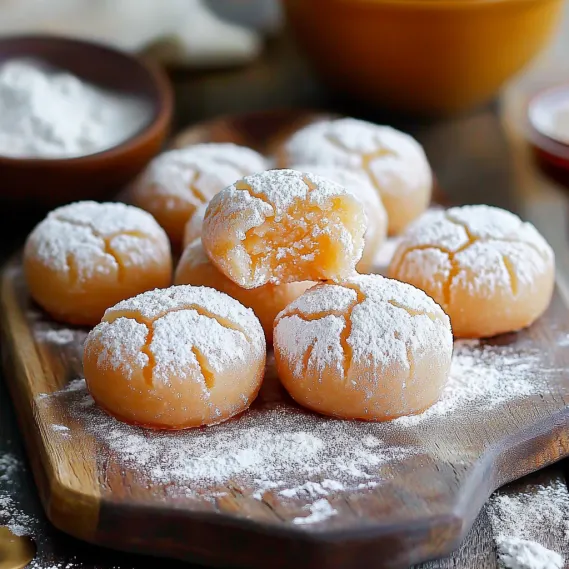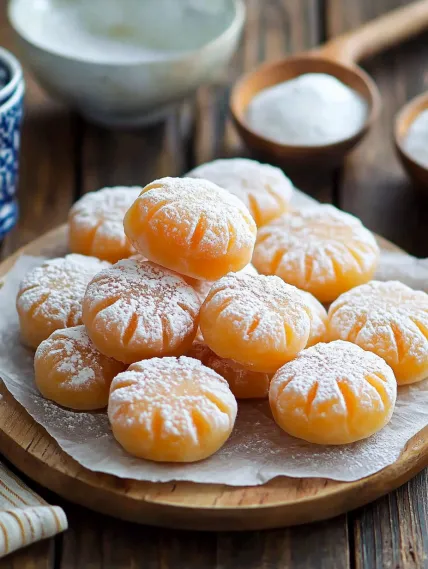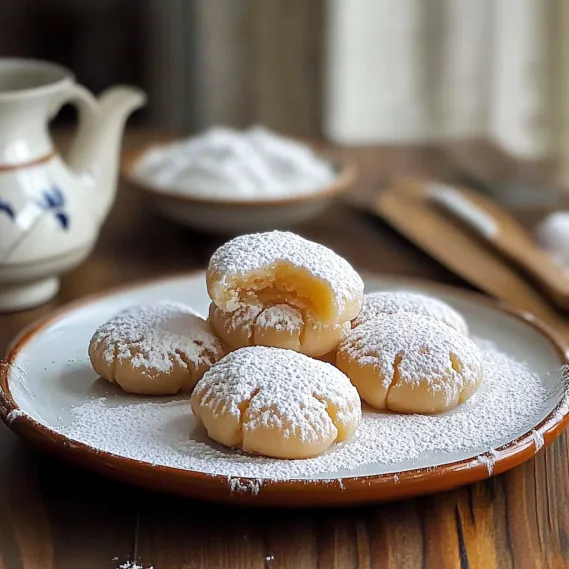 Pin it
Pin it
Thai Tea Mochi Crinkle Cookies combine Thai tea flavor with chewy mochi for unique cookie experience. The aromatic Thai tea cookie shell reveals a chewy mochi center, creating addictive textural contrast. Their beautiful crinkled, sugar-dusted exterior signals the surprise inside – a sophisticated treat bridging Thai and Japanese traditions.
I first made these cookies when looking for an impressive yet manageable dish for weekend entertaining. After experimenting with various cuts of shrimp and butter combinations, this version became an instant favorite. My husband declared them the best scampi he's ever tasted, and now guests always request them at our gatherings.
Essential Ingredients and Selection Tips
- Thai Tea Mix: Choose authentic brands with vibrant orange-red leaves
- Glutinous Rice Flour: Essential for mochi; cannot substitute regular rice flour
- Fresh Milk: Use whole milk for richest flavor throughout
- Quality Butter: Splurge on good unsalted butter for best results
- Sugars: Need both granulated and powdered varieties
I've found that adding a small amount of chicken powder (bouillon) makes a significant difference in achieving that authentic takeaway flavor. If you don't have it, mushroom powder makes an excellent substitute that adds similar umami depth without changing the overall profile of the dish.
Detailed Cooking Instructions
- Step 1: Make the Mochi Filling
- Combine glutinous rice flour, cornstarch, sugar, coconut oil, and milk. Microwave in intervals until translucent and sticky. Divide into balls using cornstarch to prevent sticking.
- Step 2: Prepare the Thai Tea Infusion
- Grind tea leaves into powder, then sift. Heat milk until steaming, add tea powder, steep for 10 minutes, then strain through fine-mesh sieve.
- Step 3: Create the Cookie Dough
- Whisk dry ingredients separately from wet ingredients with infused milk. Combine just until incorporated, then chill dough for at least 2 hours.
- Step 4: Assemble the Cookies
- Flatten dough portions, place mochi in center, and seal completely. Roll first in granulated sugar, then generously in powdered sugar for crinkles.
- Step 5: Bake to Perfection
- Bake at 350°F until edges set but centers remain soft. Cool briefly on baking sheet before transferring to rack. Look for beautiful crackled appearance.
 Pin it
Pin it
My first attempt at these cookies taught me the importance of proper filling consistency. The dough should be thick enough to hold shape but not so thick that it doesn't spread evenly. Achieving this balance ensures that the cookie center stays chewy while the exterior sets beautifully.
 Pin it
Pin it
Maximizing Thai Tea Flavor
Grind tea leaves finely before steeping in hot milk for maximum flavor without grittiness. Cool slightly before adding to preserve aromatics. Add ground cardamom to enhance traditional Thai tea profile.
Mastering the Crinkle Effect
Perfect crinkles require chilled dough, generous sugar coating, and proper oven temperature. Cold dough sets exterior quickly while interior spreads, creating cracks. Refrigerate assembled cookies briefly before baking for dramatic results.
Storage and Make-Ahead Tips
Best within 24 hours when mochi texture is ideal. Prepare components separately up to three days ahead. Store mochi with cornstarch to prevent sticking and keep dough refrigerated until assembly. For longer storage, freeze unbaked cookies for up to three months.
Serving Suggestions
Pair with Thai iced tea or balance sweetness with unsweetened green tea. Combine with other Asian-inspired sweets for themed platters. Briefly explain the unique texture to guests unfamiliar with mochi.
 Pin it
Pin it
Chef's Helpful Tips
- Use kitchen scale for uniform cookies and even baking
- Sift powdered sugar before use to remove lumps
- Add orange food coloring for vibrant appearance
- Use slightly wet hands when handling mochi
- Chill assembled cookies briefly before baking
Frequently Asked Questions
- → What is Thai tea and where can I find it?
- Thai tea is a type of flavored tea that typically contains black tea mixed with spices like star anise, cardamom, and tamarind, giving it a distinctive orange color and fragrant flavor. You can find loose-leaf Thai tea at Asian grocery stores, specialty tea shops, or online retailers. If you can't find Thai tea, you can substitute with a strong black tea mixed with a pinch of cinnamon, cardamom, and star anise, though the flavor profile will be slightly different.
- → Can I make the mochi and cookie dough ahead of time?
- Yes, both components can be prepared ahead of time. The mochi can be made up to a day in advance - just wrap each portion individually in plastic wrap and store at room temperature (not refrigerated, as this will harden the mochi). The cookie dough can be refrigerated for up to 3 days or frozen for up to a month. If frozen, thaw the dough in the refrigerator overnight before using.
- → Why do my cookies need to be rolled in granulated sugar before powdered sugar?
- The double-coating method is crucial for achieving the perfect crinkle appearance. The granulated sugar creates a barrier between the cookie dough and the powdered sugar, preventing the powdered sugar from being completely absorbed into the dough during baking. This results in more defined white crinkle patterns on the finished cookies. If you skip the granulated sugar step, the powdered sugar may disappear or look uneven after baking.
- → What is glutinous rice flour and can I substitute it?
- Glutinous rice flour (also called sweet rice flour) is made from ground sticky rice and gives mochi its characteristic chewy texture. Despite its name, it doesn't contain gluten. For authentic mochi texture, glutinous rice flour is essential and cannot be substituted with regular rice flour or other flour types. Look for it in Asian grocery stores, the international section of larger supermarkets, or online. Brands like Mochiko or Erawan are commonly available.
- → My mochi is too sticky to work with. What should I do?
- Stickiness is a common challenge when working with mochi. Make sure to be generous with cornstarch when handling the mochi - coat your hands, work surface, and the mochi pieces thoroughly. If it's still too sticky, you can add a bit more cornstarch to the mochi directly and knead it in. Alternatively, you can chill the mochi briefly (15-20 minutes, not longer) to make it easier to handle. Working with slightly damp hands can sometimes help too, as the moisture creates a barrier with the sticky mochi.
